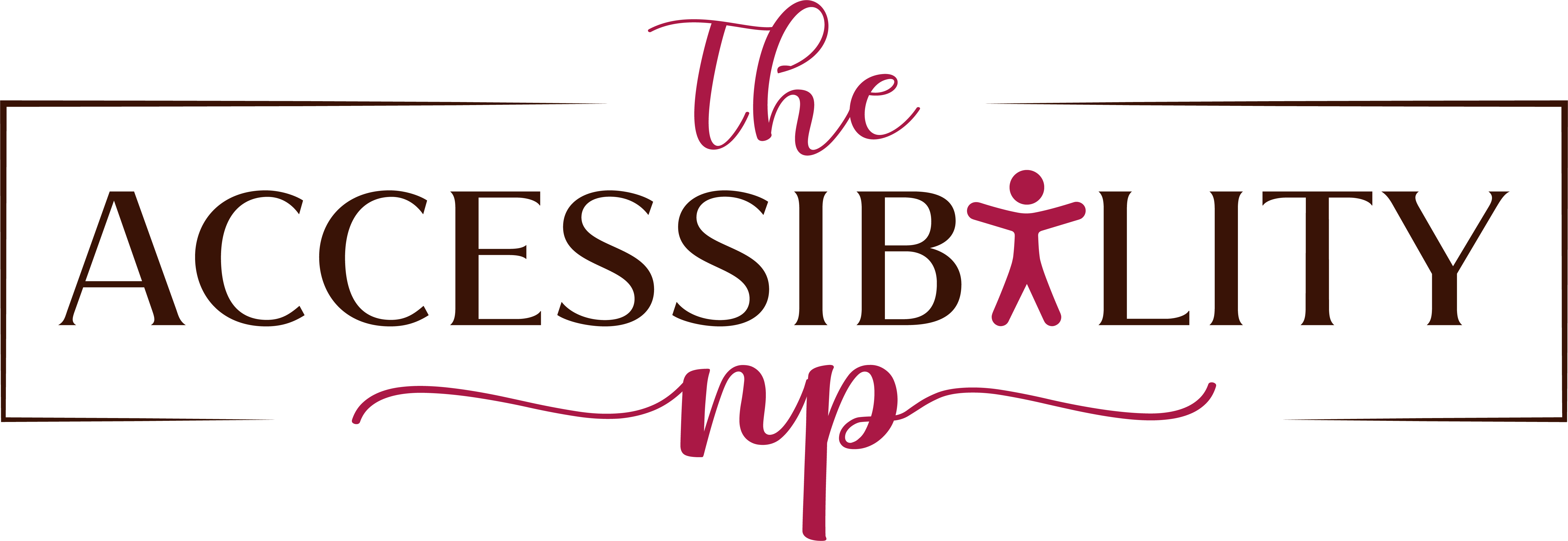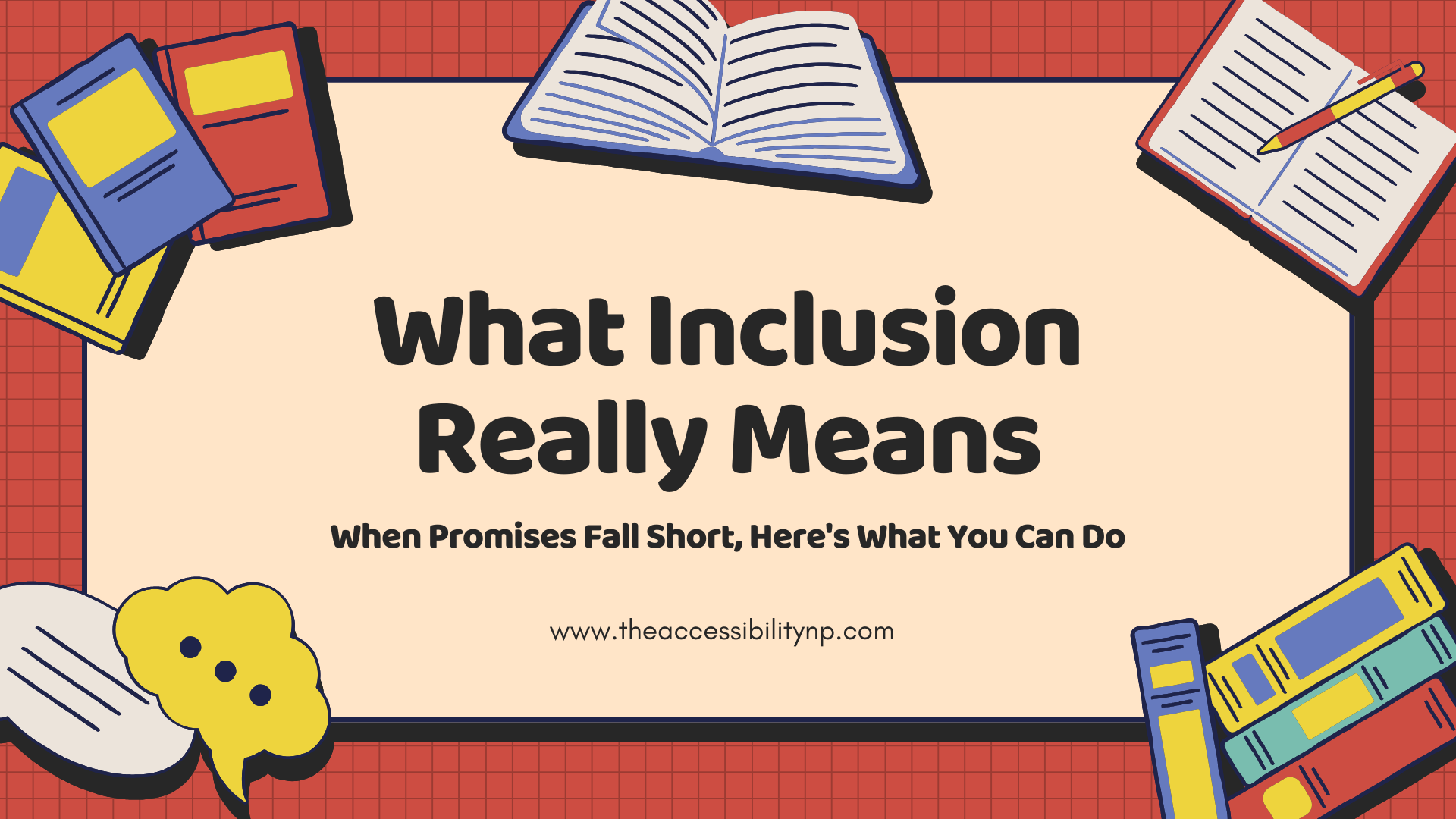Inclusion is a word we see everywhere—school mission statements, posters in hallways, special education plans, and IEP goals. But real inclusion isn’t just a feel-good buzzword. It’s a right. It’s protected by law. And more importantly, it’s a daily practice that requires commitment, accountability, and intention.
For families of disabled and neurodivergent students, the beginning of a school year often comes with hope. Hope that this time, things will be different. Hope that your child will be welcomed, included, and understood for who they are. But what happens when the reality doesn’t match the promise? What do you do when you realize your child isn’t receiving an inclusive education?
This post breaks down what inclusion really means, how to recognize when it’s missing, and what steps you can take if your child—or your student—is being excluded in ways that might not be obvious at first glance.
What Inclusion Is (and What It’s Not)
Inclusion means disabled students belong in the school community—in every setting, not just a separate classroom. It means they’re not guests or add-ons. They are students with equal rights to learn, participate, and thrive.
Real inclusion is:
-
Being physically present in general education classrooms and activities
-
Having meaningful access to curriculum, instruction, and communication
-
Being supported to engage, not just to “get through the day”
-
Being seen as capable, even when support is needed
-
Participating in school culture—assemblies, field trips, specials, and social moments
Inclusion is not:
-
Being placed in the back of the room without interaction
-
Being assigned a paraprofessional who speaks for the student instead of supporting them to speak
-
Being pulled out for most of the day to complete separate assignments
-
Only being allowed in general education classes if they behave “appropriately”
-
Making the student conform to a system that refuses to bend
Inclusion doesn’t mean we ignore a student’s needs. It means we build systems and classrooms that support all learners.
The Law Protects Inclusion
Under the Individuals with Disabilities Education Act (IDEA), students with disabilities are entitled to be educated in the least restrictive environment (LRE). This means:
“To the maximum extent appropriate, children with disabilities… are educated with children who are nondisabled, and special classes, separate schooling, or other removal… occurs only when the nature or severity of the disability is such that education in regular classes with the use of supplementary aids and services cannot be achieved satisfactorily.”
In plain language: being disabled is not a reason to be excluded. Supports and accommodations must be put in place to make general education accessible. Exclusion should always be the last resort—not the first step.
Signs Your Child Isn’t Receiving an Inclusive Education
Sometimes exclusion is subtle. It’s not always about placement. It’s about how a child is treated in that placement.
Here are signs to watch for:
-
Your child is assigned to a general education classroom but spends most of the day pulled out
-
They are not participating in group projects, discussions, or hands-on activities
-
They are physically present but not being taught grade-level content
-
Their AAC device is not available during all subjects
-
Behavior is used as a reason to withhold access to general education
-
Staff speak about your child’s deficits more than their goals or strengths
-
Peers don’t know their name, or say “they don’t really go here”
-
You receive minimal updates about their progress or engagement
Inclusion isn’t just about where a child learns. It’s about how they are supported, how their voice is honored, and whether they are building relationships and growth inside that space.
What to Do If You Feel Inclusion Is Missing
If your child is not receiving an inclusive education—or if you’re an educator witnessing exclusion—there are steps you can take to start addressing it.
1. Document What You’re Seeing
Start a running list of concerns:
-
When is your child being removed from class?
-
Are they missing any special events, field trips, or electives?
-
Are they completing the same assignments as peers with appropriate modifications, or being given separate work altogether?
-
Are supports being denied or inconsistently provided?
If you’re a teacher or staff member, document patterns and dates. Write down what was observed, who was involved, and how it was addressed.
Documentation creates a clear picture—and helps you advocate more effectively.
2. Request a Meeting With the School Team
Don’t wait for the next IEP meeting if your concerns are immediate.
You can email the case manager, principal, or special education director and request a meeting to discuss how inclusion is being supported. Be specific in your request:
“I’d like to meet to discuss my child’s access to general education and whether the current supports are meeting their needs in the least restrictive environment.”
This shifts the conversation from “we’re unhappy” to “we want to problem-solve within your legal obligation.”
3. Ask for Data and Observations
It’s okay to ask:
-
What subjects is my child included in?
-
How long are they in general education daily?
-
What supports are being used to help them participate?
-
How is success in inclusive settings being measured?
-
Are academic goals aligned to grade-level standards?
If your child is excluded due to behavior, ask for data showing patterns. Ask what supports were provided before exclusion happened.
4. Use the IEP as a Tool, Not a Barrier
The IEP should reflect real, meaningful inclusion. Look closely at the placement section and the services page. Do the minutes match your child’s actual day? Are they receiving services inside the classroom, or being pulled out for all support?
You can request changes, including:
-
More time in general education
-
Services delivered in inclusive settings
-
Visual supports, AAC access, or peer support
-
Clear goals around participation, not just compliance
Push back against language like “not ready for general ed.” Ask: What supports would make them ready? Readiness is a barrier we create—not a truth about the child.
5. Bring in Allies and Advocates
You don’t have to do this alone.
If your concerns are not being taken seriously, or if meetings become combative, bring in support. This could be:
-
A special education advocate
-
An outside therapist or specialist
-
Another trusted team member from a previous school year
-
A parent liaison or community organization
Sometimes, just knowing you’re not the only one at the table changes the power dynamic.
6. Center Your Child’s Voice
If your child can share their experience, listen. Even if they can’t say “I don’t feel included,” you can observe their body language, energy, and behavior.
-
Are they excited to go to school—or do they dread it?
-
Do they talk about friends, or do they feel left out?
-
Are they making academic progress or constantly being told what they “can’t do”?
-
Do they shut down during homework that seems disconnected from classroom learning?
Inclusion should feel empowering. When it doesn’t, children often show us in subtle (and not-so-subtle) ways.
For Educators: How to Champion Inclusion
If you’re a teacher or staff member and you see a student being excluded, you are not powerless. You can:
-
Collaborate with the IEP team to brainstorm inclusive strategies
-
Model inclusion by using universal design in your lessons
-
Check in with the student and offer them a meaningful role in the classroom
-
Advocate for training for yourself and your colleagues
-
Partner with families, not just inform them
Inclusion doesn’t mean you have all the answers. It means you’re committed to asking the right questions and refusing to accept systems that leave students behind.
Final Thoughts
Inclusion isn’t a placement. It’s a mindset. It’s the decision to believe that every student—regardless of ability, communication style, or support need—has the right to be part of the classroom, the lesson, and the school community.
If your child isn’t being included, it’s not your fault. And it’s not something you just have to accept. You can ask questions. You can raise concerns. You can demand better—not just because it’s the law, but because your child deserves a space that recognizes their worth.
You’re not just advocating for access.
You’re advocating for belonging.
And that matters—every single day.
—Yolanda
The Accessibility NP

